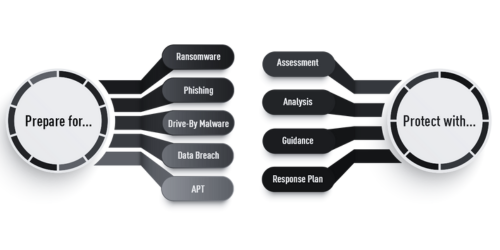Risk Assessments
What is a Risk Assessment?

Steps of a Cyber Security Risk Assessment

Identify and Document Network Asset Vulnerabilities
The first step in a cyber security risk assessment is to identify and document the vulnerabilities associated with an organisation’s IT assets. This includes inventorying these assets and assessing the potential risks and vulnerabilities associated with each.
Identify and Use Sources of Cyber Threat Intelligence
Cyber threat intelligence is internal or external information that can help identify cyber security risks. Many organisations, including CISA, US-CERT, and cyber security companies, offer access to cyber threat intelligence feeds. Additionally, an organisation can collect internal threat intelligence based on past cyberattacks and its existing security architecture.


Identify and Document Internal and External Threats
With a comprehensive view of its IT assets and an understanding of major potential threats, an organisation can search for both internal and external threats. This may include scanning systems for indicators of compromise (IoCs), looking for unusual behaviour in log files, and auditing configuration files for insecure settings or unauthorised changes.
Identify Potential Mission Impacts
Different cyber security risks have varying potential impacts on the organisation. For example, a ransomware infection on the corporate database has a greater impact than a similar attack against a single user’s workstation. Identifying the impacts of a cyber threat on the organisation is essential to quantifying the risk it poses.


Use Threats, Vulnerabilities, Likelihoods, and Impacts to Determine Risk
At this stage in the assessment, an organisation has a clear understanding of the various threats and vulnerabilities it faces and the potential impact of each. It can also determine the likelihood of each type of attack using cyber threat intelligence. Based on this information, it is possible to quantify risk based on the combination of the likelihood and impact of each individual threat.
Identify and Prioritise Risk Responses
After quantifying the risk of each threat and vulnerability, an organisation can prioritise these issues. This information can inform remediation efforts, ensuring that major risks are addressed as quickly as possible and maximising the ROI of remediation efforts.

How a Cyber Security Risk Assessment Benefits Organisations
A cyber security risk assessment provides an evaluation of an organisation’s defences against cyber threats. Some of the ways that this assessment can benefit the organisation include:
- Vulnerability Remediation – The outcome of a cyber risk assessment is a prioritised list of vulnerabilities that the organisation can address to enhance its cyber defences.
- Security Evaluation – The cyber risk assessment provides an organisation with insights into which of its defences are effective and which require improvement.
- Cyber Security ROI – A cyber security risk assessment can help demonstrate the returns on cyber security investment by showing the organisation’s reduced risk of cyberattacks.
- Regulatory Compliance – Certain regulations require regular security assessments to ensure that an organisation is properly protecting sensitive data. Even if an assessment is not mandated, it can be a useful exercise to prepare for a compliance audit.
- Insurance Coverage – The rise in cyber security risk has made cyber security insurance more expensive and challenging to acquire. A positive cyber risk assessment may help an organisation improve its chances of obtaining a policy or reduce the cost of an existing one.




